|
|
|
Sort Order |
|
|
|
Items / Page
|
|
|
|
|
|
|
| Srl | Item |
| 1 |
ID:
142842
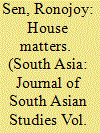

|
|
|
|
|
| Summary/Abstract |
While the Bharatiya Janata Party (BJP) alone enjoys a majority in the current Lok Sabha (lower house of parliament), it lacks numbers in the Rajya Sabha (upper house). This paper examines how the opposition mobilised, especially in the Rajya Sabha, to counter some of the Modi government's legislative agenda during its first year, and the government's response of promulgating ordinances. A particular focus is on the issue of amending the 2013 land acquisition legislation passed by the previous Congress-led United Progressive Alliance. The paper also considers Modi's speeches inside and outside parliament. His articulation of the government's agenda, particularly on land acquisition, and his views on the role of the opposition are analysed. The paper makes two broad arguments. First, the Rajya Sabha was possibly reclaiming some of its functions, as envisioned by India's Constituent Assembly, in bringing a ‘balance’ to legislative decision-making. India's political evolution, from a one-party dominant system to one with several strong regional parties, has meant a changed role for the Rajya Sabha. Second, in its parliamentary discourse, Modi and the BJP were caught in the contradictory positions of battling the perception that they were too close to corporate interests, even as they attempted to project an inclusive and pro-poor image.
|
|
|
|
|
|
|
|
|
|
|
|
|
|
|
|
| 2 |
ID:
094016


|
|
|
|
|
| Publication |
2010.
|
| Summary/Abstract |
The primary question addressed by this essay is: How are religion and religious propaganda in election campaigns in India regulated? I study this question by looking at the rulings of the Supreme Court, which is the final arbiter in all matters related to electoral disputes. The relevant portion of the Representation of the People Act (RPA)-the legislation governing the conduct of Indian elections passed in 1951-that relates to regulating religion are various provisions of Section 123.1 Section 123(3) deems as 'corrupt practice' election candidates or their agents appealing for votes on the grounds of religion or religious symbols; Section 123(2)(a)(ii) defines as corrupt practice attempts to induce a candidate or voter to believe that he would become an object of 'divine displeasure or spiritual censure'; and Section 123(3A) considers as corrupt practice attempts to promote enmity on grounds of religion, race, community or language. More recently, Section 123(3B) does the same for candidates propagating the practice of sati or glorifying it. In addition, Section 125 of the RPA makes attempts to promote enmity or hatred on the 'grounds of religion, race, caste, community or language' a punishable offence.
|
|
|
|
|
|
|
|
|
|
|
|
|
|
|
|
| 3 |
ID:
129648
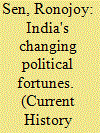

|
|
|
|
|
| Publication |
2014.
|
| Summary/Abstract |
India is due to hold a general election in April- May 2014, and speculation about the shape of the next government in New Delhi has reached a fever pitch. The presence of a new political player-the Common Man's Party (Aam Aadmi Party, or AAP)-has thrown open a contest that was already going to be difficult to call. Election forecasting in India is a perilous task in any case, given the country's diversity and fragmented politics. Nonetheless, certain broad trends can be discerned. One is the parlous state of the country's oldest party, the Indian National Congress. The Congress has been in government during much of independent India's history. For the past decade it has governed the nation as the leader of the United Progressive Alliance (UPA), and its popularity has steadily declined. After the 2014 general election, it is unlikely to be in a position to form a new government.
|
|
|
|
|
|
|
|
|
|
|
|
|
|
|
|
| 4 |
ID:
183196
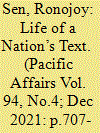

|
|
|
|
|
| Summary/Abstract |
This review essay briefly discusses Granville Austin’s landmark study of the working of the Indian Constitution and its critics, reviews three recent books on that Constitution, and evaluates the extent to which these new works have been able to take constitutional studies in new directions. All three books shine a light on the critical role of the Constitution and the courts in Indian democracy. While the authors are well aware of contemporary challenges to constitutionalism and have written on them elsewhere, this does not fully come through in their books. Despite this shortcoming, these recent studies are indispensable in making sense of the Constitution and its role in Indian democracy.
|
|
|
|
|
|
|
|
|
|
|
|
|
|
|
|
| 5 |
ID:
119046
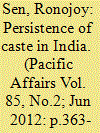

|
|
|
| 6 |
ID:
087514
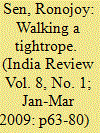

|
|
|
|
|
| Publication |
2009.
|
| Summary/Abstract |
The judiciary, particularly the Supreme Court, occupies an everincreasing
presence in the Indian landscape. The Court not only plays
an important adjudicatory role in a host of areas, but also actively
intervenes and shapes public policy and governance. Indeed, it has
waded into a bewildering variety of issues from the micro to the macro
level. In a remarkable judgment delivered in 2007 by a two-judge
bench of the Supreme Court, Justices A. K. Mathur and Markanday
Katju deviated from the case before them and pronounced:
Recently, the Courts have apparently, if not clearly, strayed into
the executive domain or in matters of policy. For instance, the
orders passed by the High Court in recent times dealt with subjects
ranging from nursery admissions, unauthorized schools, criteria for
free seats in schools, supply of drinking water in schools, number
of free beds in hospitals on public land, requirements for establishing
a world class burns ward in the hospital, the kind of air
Delhites breathe, begging in public, the use of sub-ways, the
nature of buses we board, the legality of constructions in Delhi,
identifying the buildings to be demolished, the size of speedbreakers
on Delhi roads, auto-rickshaw over-charging, growing frequency
of road accidents and enhancing of fines etc.
|
|
|
|
|
|
|
|
|
|
|
|
|
|
|
|
|
|
|
|
|